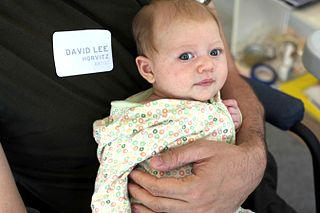
An infant or baby is the very young offspring of human beings. Infant is a formal or specialised synonym for the common term baby. The terms may also be used to refer to juveniles of other organisms. A newborn is, in colloquial use, an infant who is only hours, days, or up to one month old. In medical contexts, a newborn or neonate is an infant in the first 28 days after birth; the term applies to premature, full term, and postmature infants.
A facial expression is one or more motions or positions of the muscles beneath the skin of the face. According to one set of controversial theories, these movements convey the emotional state of an individual to observers. Facial expressions are a form of nonverbal communication. They are a primary means of conveying social information between humans, but they also occur in most other mammals and some other animal species.

Nonverbal communication (NVC) is the transmission of messages or signals through a nonverbal platform such as eye contact (oculesics), body language (kinesics), social distance (proxemics), touch (haptics), voice (paralanguage), physical environments/appearance, and use of objects. When communicating, we utilize nonverbal channels as means to convey different messages or signals, whereas others can interpret these message. The study of nonverbal communication started in 1872 with the publication of The Expression of the Emotions in Man and Animals by Charles Darwin. Darwin began to study nonverbal communication as he noticed the interactions between animals such as lions, tigers, dogs etc. and realized they also communicated by gestures and expressions. For the first time, nonverbal communication was studied and its relevance questioned. Today, scholars argue that nonverbal communication can convey more meaning than verbal communication.

Strabismus is a vision disorder in which the eyes do not properly align with each other when looking at an object. The eye that is pointed at an object can alternate. The condition may be present occasionally or constantly. If present during a large part of childhood, it may result in amblyopia, or lazy eyes, and loss of depth perception. If onset is during adulthood, it is more likely to result in double vision.

An attachment theory is a psychological, evolutionary, and ethological theory concerning relationships between humans. The most important tenet is that young children need to develop a relationship with at least one primary caregiver for their survival, and for them to develop a healthy social and emotional functioning. The theory was formulated by psychiatrist and psychoanalyst John Bowlby (1907–1990).

A maternal bond is the relationship between a biological mother/caregiver and her child or baby. While typically associated with pregnancy and childbirth, a maternal bond may also develop in cases later on in life where the child is unrelated, such as in the case of an adoptee or a case of blended family.
Cuteness is a type of attractiveness commonly associated with youth and appearance, as well as a scientific concept and analytical model in ethology, first introduced by Austrian ethologist Konrad Lorenz. Lorenz proposed the concept of baby schema (Kindchenschema), a set of facial and body features that make a creature appear "cute" and activate ("release") in others the motivation to care for it. Cuteness may be ascribed to people as well as things that are regarded as attractive or charming.

Infant vision concerns the development of visual ability in human infants from birth through the first years of life. The aspects of human vision which develop following birth include visual acuity, tracking, color perception, depth perception, and object recognition.

Attachment in children is "a biological instinct in which proximity to an attachment figure is sought when the child senses or perceives threat or discomfort. Attachment behaviour anticipates a response by the attachment figure which will remove threat or discomfort". Attachment also describes the function of availability, which is the degree to which the authoritative figure is responsive to the child's needs and shares communication with them. Childhood attachment can define characteristics that will shape the child's sense of self, their forms of emotion-regulation, and how they carry out relationships with others. Attachment is found in all mammals to some degree, especially primates.
Cupboard love is a popular learning theory of the 1950s and 1960s based on the research of Sigmund Freud, Anna Freud, Melanie Klein and Mary Ainsworth. Rooted in psychoanalysis, the theory speculates that attachment develops in the early stages of infancy. This process involves the mother satisfying her infant's instinctual needs, exclusively. Cupboard love theorists conclude that during infancy, our primary drive is food which leads to a secondary drive for attachment.

Joint attention or shared attention is the shared focus of two individuals on an object. It is achieved when one individual alerts another to an object by means of eye-gazing, pointing or other verbal or non-verbal indications. An individual gazes at another individual, points to an object and then returns their gaze to the individual. Scaife and Bruner were the first researchers to present a cross-sectional description of children's ability to follow eye gaze in 1975. They found that most eight- to ten-month-old children followed a line of regard, and that all 11- to 14-month-old children did so. This early research showed it was possible for an adult to bring certain objects in the environment to an infant's attention using eye gaze.

Crying is the dropping of tears in response to an emotional state or pain. Emotions that can lead to crying include sadness, anger, excitement, and even happiness. The act of crying has been defined as "a complex secretomotor phenomenon characterized by the shedding of tears from the lacrimal apparatus, without any irritation of the ocular structures", instead, giving a relief which protects from conjunctivitis. A related medical term is lacrimation, which also refers to non-emotional shedding of tears. Various forms of crying are known as sobbing, weeping, wailing, whimpering, bawling, and blubbering.
Socialization of animals is the process of training animals so that they can be kept in close relationship to humans.
Social cues are verbal or non-verbal signals expressed through the face, body, voice, motion and guide conversations as well as other social interactions by influencing our impressions of and responses to others. These percepts are important communicative tools as they convey important social and contextual information and therefore facilitate social understanding.

Maternal sensitivity is a mother's ability to perceive and infer the meaning behind her infant's behavioural signals, and to respond to them promptly and appropriately. Maternal sensitivity affects child development at all stages through life, from infancy, all the way to adulthood. In general, more sensitive mothers have healthier, more socially and cognitively developed children than those who are not as sensitive. Also, maternal sensitivity has been found to affect the person psychologically even as an adult. Adults who experienced high maternal sensitivity during their childhood were found to be more secure than those who experienced less sensitive mothers. Once the adult becomes a parent themselves, their own understanding of maternal sensitivity will affect their own children's development. Some research suggests that adult mothers display more maternal sensitivity than adolescent mothers who may in turn have children with a lower IQ and reading level than children of adult mothers.

Parental experience, as well as changing hormone levels during pregnancy and postpartum, cause changes in the parental brain. Displaying maternal sensitivity towards infant cues, processing those cues and being motivated to engage socially with her infant and attend to the infant's needs in any context could be described as mothering behavior and is regulated by many systems in the maternal brain. Research has shown that hormones such as oxytocin, prolactin, estradiol and progesterone are essential for the onset and the maintenance of maternal behavior in rats, and other mammals as well. Mothering behavior has also been classified within the basic drives.
Endocrinology of parenting has been the subject of considerable study with focus both on human females and males and on females and males of other mammalian species. Parenting as an adaptive problem in mammals involves specific endocrine signals that were naturally selected to respond to infant cues and environmental inputs. Infants across species produce a number of cues to inform caregivers of their needs. These include visual cues, like facial characteristics, or in some species smiling, auditory cues, such as vocalizations, olfactory cues, and tactile stimulation. A commonly mentioned hormone in parenting is oxytocin, however many other hormones relay key information that results in variations in behavior. These include estrogen, progesterone, prolactin, cortisol, and testosterone. While hormones are not necessary for the expression of maternal behavior, they may influence it.

Infant crying is the crying of infants as a response to an internal or external stimulus. Infants cry as a form of basic instinctive communication. Essentially, newborns are transitioning from life in the womb to the external environment. Up to 27% of parents describe problems with infant crying in the first four months. Up to 38% identify a problem with their infant crying within the first year. Parents can be concerned about the amount of time that their infant cries, how the infant can be consoled, and disrupted sleeping patterns. Colic is used as a synonym for excessive crying of infants, even though colic may not be the cause of excessive crying.
The eye-contact effect is a psychological phenomenon in human selective attention and cognition. It is the effect that the perception of eye contact with another human face has on certain mechanisms in the brain. This contact has been shown to increase activation in certain areas of what has been termed the ‘social brain’. This social brain network processes social information as the face, theory of mind, empathy, and goal-directedness.

Breastfeeding and mental health is the relationship between postpartum breastfeeding and the mother's and child's mental health. Research indicates breastfeeding may have positive effects on the mother's and child's mental health, though there have been conflicting studies that question the correlation and causation of breastfeeding and maternal mental health. Possible benefits include improved mood and stress levels in the mother, lower risk of postpartum depression, enhanced social emotional development in the child, stronger mother-child bonding and more. Given the benefits of breastfeeding, the World Health Organization (WHO), the European Commission for Public Health (ECPH) and the American Academy of Pediatrics (AAP) suggest exclusive breastfeeding for the first six months of life. Despite these suggestions, estimates indicate 70% of mothers breastfeed their child after birth and 13.5% of infants in the United States are exclusively breastfed. Breastfeeding promotion and support for mothers who are experiencing difficulties or early cessation in breastfeeding is considered a health priority.















